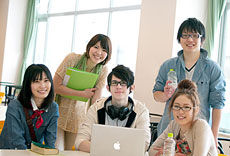What's going on in my university?
What to bring and what not to bring to Universities in Anhui Province

For Freshman:
What to bring and what not to bring to Universities in Anhui Province
Are you still moving around your room and thinking which things to bring and which not to bring before you departure to Universities in Anhui Province?
Life in Chinese universities may differ from that in your country. Take this “what to and what not to bring” list with you and then go on your preparation. Try this list; you may enjoy a time-saving and less trouble packing preparation.
Principle 1: Don’t try to plan for the whole semester.
Remember, things wouldn’t go that smoothly as you may have planned, make sure you have prepared the things you may need in the first month and that is careful enough.
Principle 2: Everything you packs, first ask yourself why you may take it.
Try to use a reasonable explain to convince yourself. Never bring "just in case" things
Principle 3: Stop the thought “things I want may never appear in China”
China enjoys a large scale of import and export, every semester; all supermarkets in campus will equip them with sufficient and all kinds of necessities meeting all demands of students from all over the world. For some particular needs, you may search on online shopping websites; goods will reach you within 3-4days.
What to Buy in Universities in Anhui Province or bring by you yourself:
(All the following things can be purchased in different stores in Universities in Anhui Province)
Sheets and Quilt/Comforter
Mattress Cover
Extension Cord
Computer and related accessories
Flashlight with extra batteries
“Husband” pillow
Fan
Wastebasket
Hangers
Toothbrush, Toothpaste, Shampoo, Soap, and other Toiletries
A cup or mug, plate, bowl, fork, knife, and spoon
Sewing kit
Small items for clean-up
Laptop lock
Umbrella
Power strip with surge protection
Highlighters, Pens, Pencils, Paper, Notebooks, Loose Notebook Paper, Binders, Post-It Notes, Paper Clips, Scissors, Tape, Stapler, Binder Clips
“What not to bring to Universities in Anhui Province” list
(In Universities in Anhui Province ,domestic and International students are not allowed to bring any of the following things to campus )
Fridge and microwave
Hot plate
Routers
Expensive equipment
Electric blanket
Speakers those are larger than 12 inches by 20 inches
Other food preparation appliances
Rice cookers
Space heaters
Hot pots
Grills
Blenders
Coffee makers (K-Cup Machines or other single cup machines included)
Dangerous substances
Pets
Mace and pepper spray
Candles
Incense
Halogen lamps
Fake IDs
Bongs, water pipes, hookah, shisha pipes, hubble-bubbles, or any object filled with water through which tobacco smoke, aromatic smoke or smoke from other substances many be drawn

USTC Grad Wins Guggenheim Fellowships
Huang Jiaxing, an alumnus of the Anhui-based University of Science and Technology of China (USTC) won the 2014 Guggenheim Fellowships, American grants given annually for creative work in the arts, or research in any branch of knowledge.
The sole winner in the field of Chemistry graduated from the School of Chemical Physics of the university in 2000. Four years later, he received his doctor's degree in the University of California, Los Angeles (UCLA), winning IUPAC Prizes for Young Chemists and ACS Prizes for Outstanding Postgraduate of Polymer Chemistry both because of his excellent thesis.
Founded in 1925, the Guggenheim Memorial Foundation awarded this year's fellowships to 178 scholars, artists and scientists who worked in the United States.
Manhattan Project scientist draws large crowds at universities
Wherever he goes in China, Roy Jay Glauber always attracts enormous attention among science students.
During a recent string of lectures at several Chinese universities — the latest one on April 18 at the University of Science and Technology of China — young students most frequently asked him about his expertise in quantum optics, which won him a share of the 2005 Nobel Prize in physics.
"Students don't raise many questions in America or in China during large lectures. The lecturers just sound off the lecture and the students ask no questions," said Glauber a day before the April 18 lecture.
To his surprise, nearly 500 students crowded into the 250-seat lecture hall at the university on Friday morning. The lecture lasted for more than two hours and he was bombarded with question after question.
Many of the young students were interested in the 89-year-old scientist's participation in the Manhattan Project during the World War II.
"I am at an age where most of the people who were in the project were older than I am are now gone. If anyone wants to hear this story, I can tell him," said the Harvard professor, who was recruited into the project in 1943 at the age of 18.
His work in the project involved calculating the critical mass for the atomic bomb.
Never too late to learn, says Grandpa Smart

Wu Tianxiong, 91, used to work at a forklift factory in Hefei before retirement. Born in Hefei in 1923 but grew up in Chongqing during the Sino-Japanese War, he wasn't able to finish school when he was young.
"Classes were often cut off by bombings and we had to hide in caves and didn't learn much from school," he said. After he returned to Hefei and became a factory worker, the want of knowledge made him a frequent visitor to library.
"I was in poor health then so I was especially interested in medical books and also made acquaintance of a professor with the University of Science and Technology of China (USTC)."

Wu retired from the factory at 60, and got a part-time job at USTC. "I did some cleaning and raised rabbits for the laboratory. When I was not working, I went to classes of the Biology Department and the young students were very nice to me, they were very patient and would explain things to me over and over again."
At 80, Wu became a junior high school student at Hefei No. 28 Middle School, which his son used to attend. "I wanted to learn English because I wanted to read more biological works," he said.

"The kids were very supportive. Normally it's the grandpa taking the grandson to school, but my grandson took me to school on the first day," Wu said proudly. His grandson, a graduate student, loves to discuss questions with him because "grandpa is so smart!"
After graduating from high school in 2005, "Grandpa Smart" studied at Anhui Agricultural University and then enrolled in an open course on Chinese culture at USTC in 2012.
"I want to set an example; I want to send a message to everyone that it's never too late to learn," Wu said.
3 USTC Grads Win Sloan Research Fellowships
Three Chinese scientists who graduated from the special class for gifted youngsters of the University of Science and Technology of China (USTC) won this year’s Sloan Research Fellowships.
The annual fellowships are awarded by the Alfred P. Sloan Foundation to "provide support and recognition to early-career scientists and scholars". According to a list released on Feb 18, 126 young faculty from around the world were granted the awards. Among them were three Anhui-based USTC alumni: Lu Shan, Yin Jun and Sun Song.
Lu, who was enrolled into the USTC upon graduating from Hefei No.1 High School in 1998 and received a doctor's degree from University of Illinois at Urbana- Champaign in 2008, is working for University of Wisconsin as an associate professor of computer science. His colleague Yin, a doctor from Princeton University, began his USTC study in 1998 too. Sun, an associate professor of maths at State University of New York, entered the USTC talent youth class in 2002.
In addition to the three USTC graduates, the list included two graduating from the Peking University and three from the Tsinghua University. Each winner will receive $50,000.
As of 2010, 38 Sloan winners were later awarded the Nobel Prize.
S. Korean learns making tofu in E China
Na Yoonseon (R) and tofu-maker Qi Yulin make tofu at a workshop in Huainan City, east China's Anhui Province, March 4, 2014. Na Yoonseon, a teacher from Cheju Halla University of South Korea, commenced her teaching career in China since September of 2012. As a tofu lover, she came to the Qixu Village of Huainan City which is renowned for tofu-making for learning various local tofu recipes. "My dream is to bring Huainan tofu recipes home and let more people taste it," said Na Yoonseon.


Anhui Charms
The otherworldly beauty of Anhui's Huangshan has long captivated travelers, poets and painters. I had long wanted to visit, so right before Spring Festival, I made a last-minute decision to go.
Besides Huangshan, I would visit the villages of Xidi and Hongcun, considered among the most beautiful and best preserved in China. Just search for images online or watch Crouching Tiger, Hidden Dragon.
In the end, Huangshan and the villages did not disappoint. To top it all off, I was able to enjoy the company of thousands of happy, spirited fellow Chinese travelers.

Huangshan
Huangshan
Huangshan Mountain is probably the most famous in China. It's not that tall, reaching 1,864 meters at its highest, but it is immensely beautiful, renowned for its jagged slopes, uniquely shaped rocks, pine trees and the "sea of clouds" that can be seen from the mountain.

This week's destination
This has made it the subject of traditional Chinese landscape paintings and poems. It's also led to Huangshan becoming a UNESCO World Heritage Site. The villages of Xidi and Hongcun are also jointly a World Heritage Site.
To get to Huangshan, I went to the town of Tunxi via a six-hour overnight train journey from Nanjing. I took a bus to Tangkou, a small town at the foot of Huangshan's southern entrance, and stayed overnight in order to get an early start on the mountain. From Tunxi, I went to Xidi and Hongcun on different days.
On the day I went to Tangkou, it was clear and sunny, and Huangshan was a magnificent sight from the ground. I got a room and the next day, I woke up early and got to the shuttle bus stop at 6 am for the shuttle to the mountain entrance. That wasn't early enough as I was greeted by a huge mass of people. Hundreds of tourists, mostly cap-wearing members of tour groups, were all lining up.
The "line" extended past the steel barrier, with the narrow entrance a chokepoint. I've been in many crowds in China, but believe me, that was the closest I've ever come to being concerned about being crushed. At times things got rowdy, and parents with children would shout out pleas to those around them to stop.
I planned to take the cable car. Instead I ended up hiking to the top since the line for the cable car was horrendous, albeit impressive. The pathway consisted of thousands of stone steps and was challenging at times, but it was made easier by the fine views, both of the mountain looming above and of the clouds below. Along the way, I passed the "immortal pointing the way," a towering standalone rock on which a few pines grew.
Three hours later, I reached the top: White Goose Ridge, which ended at the Yungu upper cable car station. I settled on going to Bright Summit (1,840 meters), passing through pine forest, frozen wells and paths with a sweeping view of mist below, one of several cloud "seas." It seemed like each vantage point or object had a name: Welcoming-guest Pine, Jade Screen Peak, Flyover Stone and so forth.
Bright Summit proved a busy crossroads featuring a dome-topped meteorological station and hotel, and offering great view of an opposite peak where there was a pond. The summit swarmed with folks causing a lively commotion that easily made one feel as if this was a busy village, as opposed to the top of one of China's most beautiful mountains.
Remember the introduction to this article, specifically the part about enjoying being with thousands of happy travelers? I was being sarcastic. The whole time I was on Huangshan, I almost felt as I was in a competition with tour groups. Believe me when I say that I've learned my lesson about traveling to famous places at the same time as many thousands.
I wanted to circle around the top and take the other cable car down, but along the way the path was becoming increasingly congested and I backtracked once it was clear I couldn't make it through in time.
I took the Yungu cable car back down, descending into gray mist 1,600+ meters above the ground. I missed out on a lot of sights at Huangshan, but what I did see convinced me the mountain is deserving of its reputation.

Hongcun village
Hongcun and Xidi
The villages of Hongcun and Xidi are both located in Yixian county, a little over an hour from Tunxi. The two villages have a history of over 900 years, featuring large, elegant houses built by wealthy merchants and prominent civil servants.
The villages are impressive reminders of a more illustrious past for this part of Anhui, formerly known as Huizhou, whose merchants used to dominate regional trade during the Ming (1368-1644) and Qing (1644-1911) dynasties. Nowadays prosperity has given way to a more sedate, but still beautiful charm.
In this region, the rural landscape is attractive also, featuring hills carpeted with tall swaying bamboo and villages with multistory homes topped with straight roofs with curved tiles and arched edges.
Xidi's most distinctive feature is a giant arch near its entrance, adjacent to a large pond at its side. With over 900 years of history, Xidi consists of main lanes, with alleys in between, filled with old houses that have weathered the test of time quite well. The houses mostly have weatherworn white exteriors and traditional-style tiled roofs with black, arched edges. Vendors sold Xuecaibing or preserved vegetable pastry, calligraphy brushes and carved wooden objects.
Besides wandering the lanes and admiring the old homes, you can enter large old multistoried wooden homes and clan halls such as Dujing Hall and Jing'ai Hall, which features a large open-air courtyard. Built by wealthy and distinguished men mostly during the Ming and Qing dynasties, the buildings feature large central halls framed by massive wooden pillars and beams. The houses also have high roofs with a rectangular opening for sunlight and air.
Where Xidi was elegant, Hongcun was beautiful. Founded in 1131, Hongcun is fronted by a small lake crossed by arched bridges that provide a fantastic sight enhanced by the reflection of the ancient houses in the water.
Like Xidi, there are several large houses built by wealthy families including Lexu, Chengzi and Jingxiu halls. These feature wooden interiors supported by ornately carved beams and columns. Chengzi Hall is particularly large, with multiple rooms left in a well-preserved state, like a museum.
A network of small open drains run through the lanes of Hongcun, conveying water from a nearby stream.
One of the most attractive sights within Hongcun is Yuezhao Moon Pond where I think one of the scenes from Crouching Tiger, Hidden Dragon was shot.
Hongcun is bigger than Xidi and features more buildings and sights, so try to allocate more time.
Despite the tourists, the two villages still retained a certain charm. Hongcun and Xidi were still places where people still live. The places weren't overrun with vendors and the vendors weren't persistent or obnoxious, as some in other tourist attractions are wont to be.
Near Yuezhao was an outdoor market where vendors sold duck, fish and even pork, split open and splayed to be hung out to dry. It definitely wasn't for tourists.
Hongcun is supposedly shaped like a cow: A hill at the west end is the head, the village is the body, Yuezhao is the stomach and the bridges are the legs. Unfortunately, I didn't have time for the whole village. I had to rush to get back to Tunxi and catch a train.
One last attraction
Finally there's one more attraction. It may be less famous than Huangshan and Hongcun, but it's also quite historic and beautiful: Tunxi's Ancient Street. Now a lot of towns across China have "ancient streets," but Tunxi's is genuinely old dating back to the Song Dynasty (960-1276) and the buildings are in amazing shape. No doubt there's been renovation, but the overall design and architecture remain intact.
I expected a small lane but I encountered a street packed with old stores that never seemed to end despite walking for almost an hour. The wooden buildings even brought to mind Kyoto in Japan. There were many restaurants and stores. Most interesting were bookstores that sold notebooks featuring covers with vintage Mao and '60s-era Communist art and quotations.
By the end, I was tired but extremely gratified. I'd like to think though Huangshan hasn't seen the last of me yet.
Rules of thumb
How to go: Tunxi is the nearest big town. Get there by direct flights from Beijing, Guangzhou, Shanghai and other major Chinese mainland cities. By train from Nanjing or Hefei; By long-distance bus from Nanjing, Hangzhou and Hefei. From Tunxi, you can take buses to Huangshan, Xidi and Hongcun.
When to go: Huangshan and the villages can be visited all year round. To see the "sea of clouds" on Huangshan, it's best to go between September and May.
Fares to enter Huangshan and take the cable car are cheaper from December to the end of February (non-peak season).



 View on mobile
View on mobile